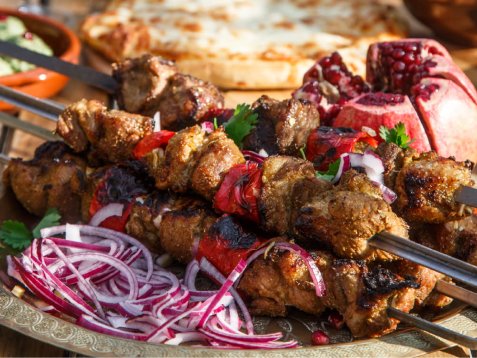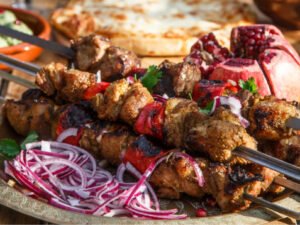In both Armenian and Middle Eastern cultures, food is more than sustenance—it’s an expression of love, generosity, and hospitality. From family gatherings to holiday feasts, meals are an important part of celebration, religion, and daily life.
The Art of Mezze: Small Dishes, Big Flavors
In both Armenian and Middle Eastern cultures, meals often start with mezze, an assortment of small dishes meant to be shared. These include:
🥙 Hummus – Creamy chickpea dip with tahini, lemon, and garlic.
🥗 Tabbouleh – A refreshing parsley and bulgur salad with tomatoes and lemon juice.
🍆 Mutabbal/Baba Ghanoush – Roasted eggplant dip blended with tahini and olive oil.
🫒 Labneh – Strained yogurt topped with olive oil, served with fresh pita bread.
Holiday and Religious Foods
✔ Easter & Christmas in Armenia – Traditional foods like pasuts tolma (vegetarian stuffed grape leaves) and gata (sweet pastry) are served during religious holidays.
✔ Ramadan & Eid in the Middle East – Special dishes like qatayef (sweet stuffed pancakes) and mansaf (Jordanian lamb and yogurt rice dish) are prepared for breaking fast and festive gatherings.
✔ Nowruz (Persian New Year) – Foods like sabzi polo (herbed rice) and fish symbolize renewal and prosperity.
Hospitality as a Way of Life
In Middle Eastern and Armenian households, it is common to be greeted with warm bread, cheese, fresh fruit, and tea—even if you are a stranger. Food is a symbol of warmth and generosity, with the belief that no guest should ever leave hungry.
This tradition dates back to ancient times, when travelers relied on the kindness of strangers, and it remains a core value today. Whether it’s an elaborate Armenian wedding banquet or a simple Middle Eastern street food stall, the spirit of hospitality shines through in every bite.



